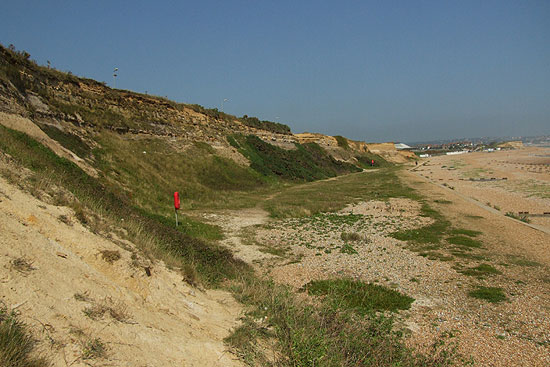We shall fight them with the beaches
Posted: 25 August 2007 21:00
Took a trip out to Bexhill today looking for the usual anti-invasion remains, plus the location of an unusual defence; the shingle projector.
As usual, I'm behind with everything and still have a previous posting yet to write. A traction engine rumbling past my house towards the local pub reminds me that I'll be out again tomorrow and probably too tired to write up the day's events, so you'll have to be patient and hope that I don't think of something to do on Monday too...
Sunday update
Shingle projectors have been at the back of my mind for 20 years. I first came across a mention of them in a transcribed document included in a local history book when I was studying GCSE history. There was no explanation as to exactly what a shingle projector was, but I sort of formed an image of a device not dissimilar to a clay pigeon trap that would hurl quantities of beach pebbles at the enemy.
Having now found a few references to shingle projectors (or shingle guns) in defence schemes, I now know that my impression was wrong; they're not point-target weapons, but more along the lines of an explosive booby-trap or fougasse.
It appears that these mine devices were dug into cliff faces and could be detonated by remote control or by trip wire.
Having the locations of some of these, I homed in on Galley Hill, Bexhill, an area I've been meaning to explore for some time now.
I decided to take my bike on the train instead of driving and walking, as I wanted to take in a lot of ground, and the bank holiday traffic can be quite heavy.
Arriving at Galley Hill, I stopped to investigate the locations of an artillery observation post and some pillboxes (all long gone) before making my way down and round to the foot of the cliffs.

According to the information I have, two shingle projectors were situated three feet up the cliff face somewhere in this concave area, presumably far enough apart for them to each be detonated independently without triggering the other.
This cliff was considered scaleable (I actually saw one idiot climb down this face), and so a nasty surprise of shingle being projected at close range would have made things uncomfortable for invading troops.
This is a good example of how there's no substitute for fieldwork aided by documentary research; walking the ground gives no indication of the defences of this cliff, and I only knew of the shingle guns sited here from defence schemes. However, a textual description alone doesn't give the full impression, so being out in the landscape is vital in reconstructing and understanding the defences.
This point was brought home to me several times on this visit alone; I carried a copy of the relevant schemes with me to refer to and this helped me identify several locations and structures that I overlooked at first glance.
I may post some more about my discoveries over the coming days if I can find time.
- Pete

Email:
Blog Latest

Bishopstone reveals its pillbox secrets
18 October 2021

Pillbox or Observation Post?
10 June 2020

Uncovering the hidden secrets of a pillbox
8 June 2019

Review of 2018
31 December 2018

Wartime Christmas in East Sussex (2)
24 December 2018
Jargon-buster
Defence scheme
A military plan of defence for a specified area. Defence Schemes were issued at numerous levels. Defence Schemes were later known as Plans to Defeat Invasion on the orders of General Montgomery.
Pillbox
Generic term for a hardened field defensive structure usually constructed from concrete and/or masonry. Pillboxes were built in numerous types and variants depending on location and role.
Shingle gun
Booby-trap possibly unique to the East Sussex coastline. Essentially a fougasse (not a flame fougasse), a quantity of explosive was dug into the base of a cliff, and packed with beach shingle. The charge could then be detonted by remote control or by tripwire, the shingle produced a shrapnel effect.
This site is copyright © Peter Hibbs 2006 - 2024. All rights reserved.
Hibbs, Peter We shall fight them with the beaches (2024) Available at: http://pillbox.org.uk/blog/216531/ Accessed: 27 July 2024
The information on this website is intended solely to describe the ongoing research activity of The Defence of East Sussex Project; it is not comprehensive or properly presented. It is therefore NOT suitable as a basis for producing derivative works or surveys!